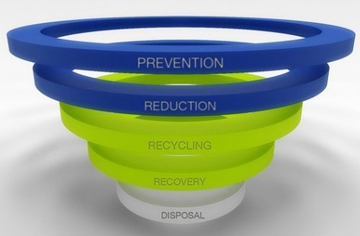Waste Haulers, Power Companies See "Green" in a Fast-Growing Waste-to-Energy Market
 Waste Management management’s says the estimated $12.3 billion in revenue it collects from hauling some 112 million tons of trash to landfills could be worth more than $40 billion a year…if it were to be used as a source of electrical power, transportation fuel and source of specialty chemicals. The potential to more than triple total revenue has lead management to aggressively pursue opportunities in the waste-to-energy space, an effort that’s being lead by Organic Growth unit senior vice president Carl Rush.
Waste Management management’s says the estimated $12.3 billion in revenue it collects from hauling some 112 million tons of trash to landfills could be worth more than $40 billion a year…if it were to be used as a source of electrical power, transportation fuel and source of specialty chemicals. The potential to more than triple total revenue has lead management to aggressively pursue opportunities in the waste-to-energy space, an effort that’s being lead by Organic Growth unit senior vice president Carl Rush. Waste Management’s competitive advantage is that it effectively controls the US waste stream, which, given its size, already is a very sizable and lucrative asset. A host of present, interrelated trends is converging to drive the valuation of that asset much higher, however. Drives to increase global energy and resource efficiency, including cradle-to-grave product development, recycling and waste reduction, as well as transition from fossil fuels to clean energy resources and reduce greenhouse gas emissions are under way. Their convergence in the present time spells opportunity for established and aspiring waste industry participants across the value chain, a development Waste Management executives clearly recognize.
Waste Management’s Waste-to-Energy Drive
Waste Management since 2009 has invested in eight waste-2-energy-and-specialty chemicals companies that are employing a range of methods and technology to turn waste into energy, including ones that use gasification, fermentation and bio-digestion.
“We don’t think the future, long term, is going to be continuing to put everything in the landfill,” Rush told Bloomberg Businessweek. “It’s going to be recovering more value from this material. The customers will demand it, the struggle for resources will demand it, and quite honestly, economically, it’s the thing we should be doing.”
Waste Management doesn’t have any particular expertise in developing in new waste-to-energy technology, or investing in companies that do, for that matter. To date, it has acted primarily as a silent investor in companies that are developing waste-2-energy technology, Credit Suisse Group analyst Hamzah Mazari told BloombergBusinessweek. That opens up potentially lucrative opportunities for those that are doing so, if they can develop and prove the type of waste-to-energy systems Waste Management is looking for.
Waste haulers aren’t the only types of businesses that see “green” in the waste industry. Willingly or unwillingly, power companies and utilities are also active in the waste-to-energy market space.
SSE Capitalizing on Waste-to-Energy Opportunities
UK utility SSE this week entered into a 50:50 joint venture with Wheelabrator Technologies to develop a 300-million-pound (~$480 million), 68-MW multi-fuel waste-to-energy-and-heat facility at SSE’s Ferrybridge power plant in West Yorkshire. With construction slated to begin late this year and end in early 2015, realizing the project will create hundreds of jobs during construction and more than 50 new full-time jobs when operational.
‘Multifuel technology is a tried and tested way of generating clean, base-load power. This new multifuel plant will provide additional diversity to SSE’s generation portfolio and make a useful contribution to ensuring we have reliable energy supplies for the future,” commented Paul Smith, SSE managing director of generation.
The SSE-Wheelabrator joint venture, Multifuel Energy Ltd (MFE), will own and operate the multi-fuel waste-to-energy facility, selling the electricity generated on to SSE. Hitachi Zosen Inova (HZI), which has successfully built other multi-fuel power plants, is carrying out the construction.
For the plant’s feedstock waste, MFE is turning to 3SE, another SSE joint venture, this one with Shanks Plc. SSE and 3SE have entered into a long-term fuel procurement contract that will provide processed waste-derived fuels for the Ferrybridge multi-fuel waste-to-energy plant using waste taken from nearby communities. To convert the waste collected into fuels “3SE intends to develop a new Mechanical Biological Treatment (MBT) and Anaerobic Digestion (AD) facility,” which is expected to be operational come 2015, according to SSE.
You can return to the main Market News page, or press the Back button on your browser.

